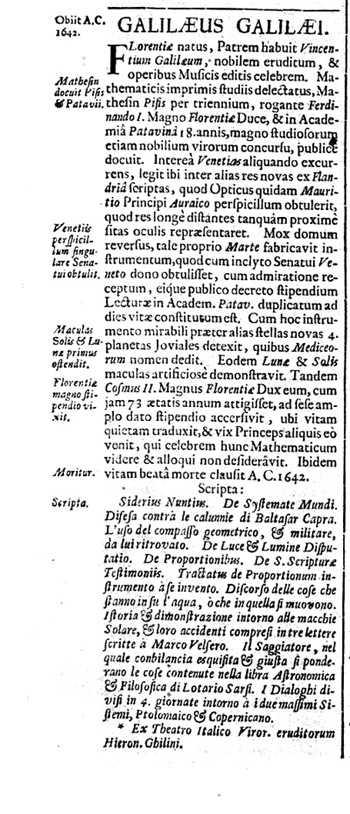
L'incisione è tratta dal libro di Paul Freher (1611-1882) intitolato:
D. Pauli Freheri ... Theatrum virorum eruditione clarorum. In quo vitae & scripta theologorum, jureconsultorum, medicorum & philosophorum, tam in Germania superiore & inferiore, quam in aliis Europae regionibus, Graecia nempe, Hispania, Italia, Gallia, Anglia, Polonia, Hungaria, Bohemia, Dania & Suecia a seculis aliquot, ad haec usque tempora, florentium, secundum annorum emortalium seriem, tanquam variis in scenis repraesentantur. Opus omnibus eruditis lectu jucundissimum in quatuor partes divisum, quarum I. Theologos varios. II. Magnates, jurisconsultos & politicos. III. Medicos, chymicos, botanicos, anatomicos &c. IV. Philosophos, philologos, historicos, mathematicos, poetas, &c complectitur. Cum indice locupletissimo
Noribergae, impensis J. Hofmanni, & typis haeredum Andreae Knorzii, 1688
DESCRIZIONE DEL LIBRO: 4 p. l., 1206 p., l l., 1207-1562 (i.e. 1566, 15) frontespizio, 82 tavole di 34 cm (1312 ritratti)
Le pagine 245-248 sono ripetute in numerazione
Edito dal fratello Carl Joachim Freher dopo la morte dell'autore
Ogni tavola contiene 16 ritratti
frontespizio con titolo in bianco e nero e incisione.
Altre notizie sul libro:
Author: Freheri, D Pauli
Publisher: Johannis Hofmanni: 1688: Noribergae (Nurenberg)
Description: [iv], 722pp (340 x 220 mm)
Engraved frontispiece and title page, rubricated title page, 30 pages of engraved portraits, each page containing 16 portraits, and an engraved headpiece to the dedication page.
This book, which is a very large folio of nearly 1800 pages, contains biographies of famous men and is illustrated by 84 large plates each containing 16 portraits. These portraits were also sold as loose plates, with the single small portrait cut out and sold separately, and these tiny portraits - about 6 by 4 centimetres - can be found in practically all the cabinets of prints in Europe.
FREHERUS, P. Theatrum virorum eruditione clarorum. Tomus posterior in quo vitae et scripta theologorum, jurisconsultorum, medicorum et philosophorum, tam in Germania Superiore et Inferiore, quam in aliis Europae regionibus [...]. Noribergae, Impensis Johannis Hofmanni, Bibliopola. Literis Christiani Sigismundi Frobergii. 1688, p. 944-946. Met portr.

La descrizione che segue il ritratto è la traduzione del testo dedicato a Galileo dall'abate Girolamo Ghilini (1589-1668) nella sua opera:
TEATRO D'HUOMINI LETTERATI APERTO DALL' ABBATE GIROLAMO GHILINI ACADEMICO INCOGNITO. ALL' ILLUSTRISSIMO SIGNOR, IL SIGNOR. GIO: FRANCESCO LOREDANO. Venetia: Per li Guerigli, 1647.
di cui trovo la seguete descrizione bibliografica:
"Two volumes in one. [10],224; [8],242pp. Engraved title vignettes". Potrebbe darsi che anche il ritratto provenga dall'opera del Ghilini.
Altre notizie. Il libro
Freher, Paul. Theatrum virorum eruditione clarorum. Nuremberg: impensis Johannis Hofmanni, 1688
è stato « Book of the Month of The Royal Society's library», con la seguente presentazione
The cult of celebrity is not a feature unique to the twenty first century, as Freher's majestic work, 'Theatrum virorum' shows. As the seventeenth century equivalent to 'Who's Who', it brings together biography and portraiture of the rich and famous across Europe. In an age before mass media, images like those in Freher's book would have connected in the minds of scholars the lives of the great names of Europe with these pictorial representations. Among those featured are Galileo, Paracelsus, Duns Scotus and Albertus Magnus.
This book, in two large volumes of nearly 1600 pages, is illustrated by 84 large plates each containing 16 portraits. These portraits were also sold as loose plates, and these tiny portraits - about 6 by 4 centimetres - can be found in practically all the cabinets of prints in Europe. The volumes have recently come to light at the Royal Society in a project to reorganise our rare books room to provide our collections with better preservation conditions.
The Royal Society's library and archives contain a wealth of portraiture, notably of scientists. Freher's work is just one of the many ways in which the history of scientific portraiture can be traced through our collections.